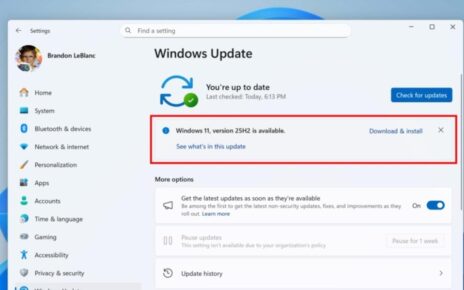Netflix is testing a new subtitle format that focuses solely on dialogue, removing non-dialogue audio cues like sound effects and music descriptors. This move aims to reduce visual distraction for readers who simply want to follow the spoken words, while still offering traditional captions for those who rely on the fuller context. The rollout starts with new Netflix original programming, beginning with the upcoming season of a popular series, and will be available in multiple languages. Netflix has indicated that the option may eventually be extended to older titles in the library, including titles not produced by Netflix. The traditional closed captions will remain available, labeled as the standard English CC, whereas the dialogue-only option is labeled simply as English (or the viewer’s preferred language).
Introduction
Netflix is expanding its subtitle toolbox by adding a dialogue-only option that concentrates on the words spoken by characters. This approach deliberately excludes the ancillary audio details—such as character names during rapid exchanges, musical cues, and descriptive sound effects—that have populated standard closed captions for years. The change reflects ongoing attempts across streaming platforms to balance accurate transcription with a clean, readable view that minimizes distraction while preserving accessibility. By starting with new Netflix original programming, Netflix aims to fine-tune the experience before potentially scaling the feature to the broader catalog, which would give a broader audience the chance to tailor subtitles to their preferences. The presence of both formats—traditional CC and dialogue-only subtitles—offers viewers a choice, allowing anyone to switch depending on their current environment, language needs, or personal reading style. This dual-approach underscores the evolving role of subtitles in modern streaming, where accessibility intersects with viewing comfort and readability.
The motivation behind dialogue-only subtitles
The move toward dialogue-only subtitles is rooted in a recognition of diverse viewing scenarios and the evolving nature of contemporary audio-visual storytelling. A growing share of households consumes media with subtitles, yet not all subtitle readers are deaf or hard of hearing. In many homes, dialogue clarity can be compromised by a variety of factors: soft-speaking actors, rapid-fire exchanges, or the way streaming services compress audio to fit bandwidth and playback conditions. A sizable portion of viewers relies on subtitles to catch every spoken word, while others find traditional captions visually busy or distracting when they mainly want to focus on the dialogue stream itself.
Several converging forces help explain why this is becoming a practical improvement. First, performers in modern television and film deliver more naturalistic performances, often speaking with less projection and more conversational pace. The result is a higher likelihood that dialogue can be missed, especially on devices that lack high-fidelity sound systems. Second, streaming platforms compress audio more aggressively than physical media, which can suppress subtle dialogue nuances and reduce intelligibility, particularly in midrange and higher frequencies where speech resides. Third, the wide variability in home audio setups—ranging from high-end soundbars to compact TV speakers—creates a challenging dynamic: editors must preserve the integrity of spoken lines while ensuring the overall sound remains accessible on lower-quality speakers. This combination of performance style, audio compression, and hardware diversity has created a gap where dialogue fidelity and reader clarity can diverge, prompting a reexamination of how subtitles are presented.
In this context, the dialogue-only subtitle format is positioned as a practical, viewer-centric option. It intentionally strips away descriptive sound cues and music annotations that some readers may find intrusive when their sole aim is to follow the spoken content precisely. The result is a more text-forward reading experience. While this approach reduces contextual audio signals, it preserves the core content—the spoken words themselves—so that language learners and multilingual audiences can still access the material in their preferred language. This shift is not presented as a replacement for traditional captions but as a complementary mode that serves a distinct audience with different reading preferences and environmental constraints.
How the new subtitles work and what they include
The dialogue-only subtitles are designed to present the actual words spoken on screen without the surrounding audio descriptors. In practical terms, this means that the subtitles will display the dialogue as it is spoken, without the additional notes that have long been part of standard captions—for example, no references to dramatic quotes, no mention of musical cues, and no on-screen character annotations tied to sound design. Even when the program is in a language other than English, the dialogue-only approach adheres to the spoken dialogue in that language, offering a clean transcription that viewers can read quickly and accurately.
Traditional closed captions remain available within the platform. These are the familiar English CC captions that include a broader set of information: speaker names when necessary, music cues like “dramatic music intensifies,” and sound effects such as “loud explosion.” The availability of both formats gives users a clear and simple choice: retain the full, information-rich captions or switch to a minimalist version that prioritizes the spoken words themselves. The new dialogue-only option is labeled plainly as English (or the viewer’s chosen language), while the standard captions continue to be labeled English CC. This labeling distinction makes it easy for users to select the mode that best suits their current viewing context.
From a production perspective, offering a dialogue-only subtitle track requires careful alignment with the on-screen dialogue. It relies on accurate transcription timing, ensuring lines appear in sync with the spoken words for comfortable reading speeds. It also assumes that readers can follow rapid exchanges without the aid of dialogue cues or on-screen annotations that would normally help identify who is speaking in a busy scene. Netflix’s approach here emphasizes readability and direct word-for-word transcription of dialogue, which can be particularly valuable for language learners and viewers who want an unobtrusive reading experience.
Availability: rollout, languages, and expansion plans
The dialogue-only subtitle option is set to debut in new Netflix original programming and will be available in multiple languages at launch. The initial rollout is described as a staged opening, with the option appearing first in the upcoming season of a high-profile series and then gradually expanding to other titles. Netflix has signaled that it is evaluating a broader rollout that could include titles from the wider Netflix library, including programs not produced by Netflix itself. While the exact timetable remains fluid, the company has indicated an intent to broaden language support and to make the feature accessible across a growing portion of its catalog in the coming months and years.
A key part of the plan is maintaining parity with old and new content alike. Netflix intends to keep traditional English CC captions available for all titles, ensuring that viewers who rely on the richer set of cues can continue to access them without interruption. For multilingual audiences, the language options will reflect the viewer’s chosen language, providing a consistent experience across different shows and languages. This multilingual approach not only supports native-language viewing but also helps language learners practice comprehension in a controlled, readable format that emphasizes spoken content.
In terms of device compatibility, the feature is designed to be compatible with the range of devices that Netflix supports, including smart TVs, streaming devices, mobile apps, and web players. The underlying objective is consistency across platforms so that readers experience similar levels of readability, pacing, and synchronization regardless of where they watch. While the initial release emphasizes new Netflix originals, the strategy centers on a gradual, careful expansion that prioritizes user feedback, accessibility concerns, and practical implementation considerations.
The broader tech and industry implications
The emergence of dialogue-only subtitles reflects a broader trend in streaming where accessibility features are becoming more nuanced and user-customizable. In the past, accessibility tools often presented a one-size-fits-all solution. Today, audiences increasingly expect options that align with their specific viewing environments, whether that means minimizing on-screen clutter, prioritizing dialogue clarity, or accommodating users who require detailed context for understanding. The dialogue-only captions respond to these expectations by offering a streamlined text presentation that focuses on the essential content: the spoken words.
From a technical perspective, implementing this feature involves a series of careful steps. Transcribers and editors must ensure that dialogue lines are captured accurately and timed precisely to maintain readability without overwhelming the viewer with every breath or pause. The elimination of non-dialogue descriptors reduces cognitive load for readers, which can enhance comprehension for language learners or viewers watching in noisy environments where audio fidelity is less reliable. However, removing cues like sound effects and musical cues also reduces contextual information that some viewers find helpful, particularly in scenes with significant emotional or environmental cues conveyed primarily through sound design. Balancing these trade-offs is central to the ongoing refinement of the feature.
For the broader streaming ecosystem, dialogue-only subtitles may inspire other services and studios to experiment with alternative captioning modes. This could spur a design conversation about when and how different subtitle formats best serve different audiences. It might also influence the technique of post-production captioning, with editors and translators working more closely to separate dialogue transcription from descriptive audio cues, thereby enabling flexible presentation options during playback. The result is a more dynamic subtitle ecosystem where users can tailor their reading experience to their personal preferences and situational needs.
The introduction of a dialogue-centric subtitle track does not solve all readability challenges on its own. It represents a pragmatic, user-centric adjustment within a larger framework of audio accessibility. Some audiences will gravitate toward the minimalist approach for its cleaner appearance and predictable pacing, while others will continue to depend on the richer, cue-filled captions to glean contextual information. Observers expect that this feature will push the industry to explore additional combinations of captioning elements, such as adjustable font size, line height, and even reader-friendly pacing controls, to create more personalized and inclusive viewing environments.
User experience: benefits, challenges, and expectations
For many viewers, the primary advantage of dialogue-only subtitles is a cleaner reading experience that can reduce visual clutter and improve word-level comprehension. The absence of extraneous audio cues can help readers stay focused on the words themselves, which is especially beneficial for language learners chasing precise pronunciation, phrasing, and cadence. In environments with ambient noise or suboptimal audio equipment, reading the dialogue in a straightforward, unadorned format can improve understanding and enjoyment. Viewers who frequently watch with subtitles in social settings may also find the streamlined presentation less distracting and easier to follow when multiple conversations occur on screen.
However, the dialogue-only approach also presents potential drawbacks. The loss of sound cues, music descriptors, and speaker identifications means that some contextual information is no longer readily available in the captions. In scenes with significant ambient emotion or action conveyed through auditory cues, readers may miss subtext or mood signals that those cues would historically provide. Some viewers rely on character names or speaker labels to quickly track who is speaking in dense dialogue scenes. While the new format is designed to present the spoken words cleanly, it may require adaptation for audiences accustomed to more descriptive captions. The balance between readability and contextual richness is central to user satisfaction, and Netflix’s ongoing feedback loops with viewers will shape how the feature evolves.
From an accessibility perspective, the dialogue-only option broadens the construct of what it means to be readable on screen. It acknowledges that one style of captions does not fit every situation and that some users benefit from a more text-forward approach. This aligns with a broader push toward customizable accessibility features, empowering viewers to tailor their experience to their needs. The dual-availability model—offering both dialogue-only and traditional captions—ensures that users can switch modes as needed, rather than forcing a single captioning approach on all audiences. In practical terms, this flexibility can reduce barriers to enjoyment for those who might otherwise disengage from content due to captioning fatigue or cognitive load.
Industry observers also expect this move to influence content creators and editors at the production level. Because the dialogue-only track hinges on clean transcription of spoken words, there could be increased emphasis on dialogue clarity during filming and post-production, encouraging directors and editors to prioritize pacing and diction in ways that support readability. It may also affect script coverage, dubbing planning, and localization workflows, as precise dialogue transcription becomes even more critical to ensure consistent experiences across languages. In short, the adoption of dialogue-only subtitles is not simply a display adjustment; it has the potential to ripple through production, localization, and playback practices.
Practical rollout details and future prospects
Netflix’s rollout plan emphasizes a measured introduction with a clear path to broader adoption. Initially, the feature will appear in new Netflix original programming, with the first implementation anticipated alongside a high-profile season of a popular show. Support for multiple languages signals an intention to address global audiences from the outset, recognizing the diverse linguistic practices of Netflix viewers. The company’s stated goal of eventually expanding the option to older titles in its library, including non-Netflix-produced content, signals a long-term strategic flexibility that could reshape how viewers experience a substantial portion of streaming catalogs.
The availability of both formats on Netflix—dialogue-only and traditional captions—helps mitigate potential viewer concerns about losing context. The “English” label for the new subtitle option makes it straightforward for users to identify the preferred mode, while the standard “English CC” label clearly designates the full-context captions. This labeling strategy reduces friction for readers who may want to experiment with different formats or revert to familiar captioning styles after testing the new approach. It also supports bilingual and multilingual households by enabling a consistent captioning experience across TV shows, films, and other programs in multiple languages.
As the feature expands, Netflix will likely gain valuable insights from user feedback and viewing analytics. These insights will inform refinements in transcription accuracy, timing, and the user interface for subtitle selection. The company has the opportunity to optimize performance across devices and streaming conditions, ensuring the dialogue-only mode remains legible at various font sizes and screen configurations. The ongoing assessment will help determine whether additional customization options—such as font choice, background opacity, or reading speed adjustments—are worth implementing to further enhance readability and comfort.
Broader implications for viewers and the streaming landscape
The introduction of dialogue-only subtitles contributes to a broader dialogue about how streaming services design accessibility features. It reflects a philosophy that readability and comfort can coexist with accessibility, offering users a choice that aligns with their personal preferences and practical constraints. The feature invites viewers to compare different captioning styles and decide which format best suits their current environment, whether they’re watching in a quiet living room, a bustling shared space, or on a mobile device with limited screen real estate. This choice can enhance overall satisfaction for a broad spectrum of viewers—from language enthusiasts and students to casual viewers who want a crisper reading experience.
For the media ecosystem, Netflix’s approach could spur competition to innovate in captioning and subtitle presentation. If dialogue-only subtitles prove popular, other platforms may pilot analogous options or additional formats that balance readability with contextual cues. This moment could mark a shift toward more user-centric captioning strategies, where viewers have meaningful control over how they consume dialogue. It may also encourage studios to consider how dialogue clarity and timing are handled during production, potentially influencing scriptwriting, dubbing practices, and localization workflows to better support diverse audiences.
Future iterations might explore expanding the range of captioning controls beyond language selection. Viewers could gain the ability to adjust reading speed, sentence-break pacing, or even the density of on-screen text to suit their processing preferences. Optional features, such as quick toggles for speaker labeling or device-specific layout optimizations, could further tailor the captioning experience to individual needs. Netflix’s ongoing experimentation with subtitle formats demonstrates a broader commitment to accessibility and user empowerment in the streaming era.
Conclusion
Netflix’s dialogue-only subtitles represent a thoughtful, user-focused refinement in how captions are presented. By stripping away non-dialogue audio cues and concentrating on the spoken words, the platform aims to deliver a cleaner, more readable experience that benefits language learners, viewers in challenging listening environments, and anyone seeking a distraction-free reading flow. Traditional captions remain available for those who rely on richer contextual cues, ensuring that accessibility does not come at the expense of option and choice. The rollout to new Netflix original programming and the planned expansion to multiple languages underscore Netflix’s commitment to inclusive viewing experiences while balancing production realities and technological capabilities. As streaming platforms continue to explore how best to present dialogue across diverse devices and settings, dialogue-only subtitles could become a meaningful addition to the standard toolkit, offering viewers a customized path to understanding and enjoyment in a crowded, ever-evolving media landscape.



